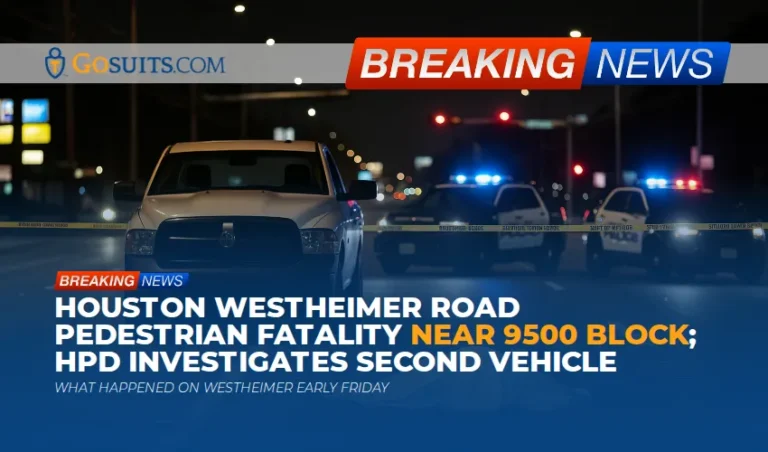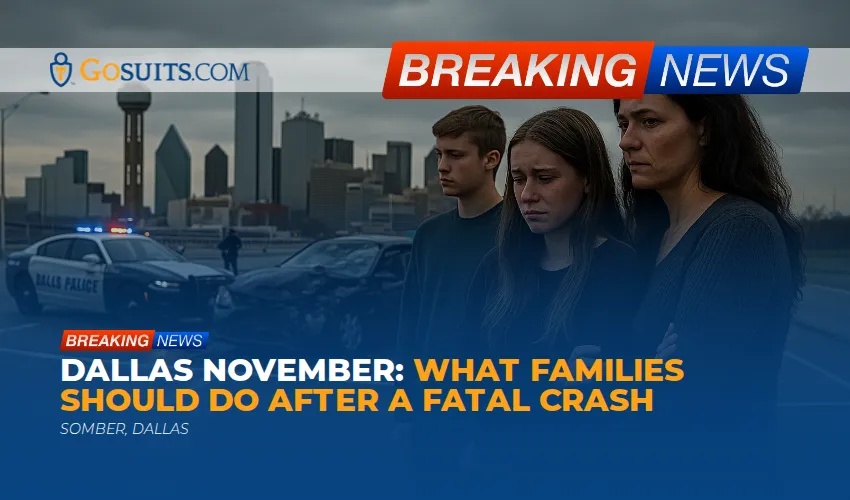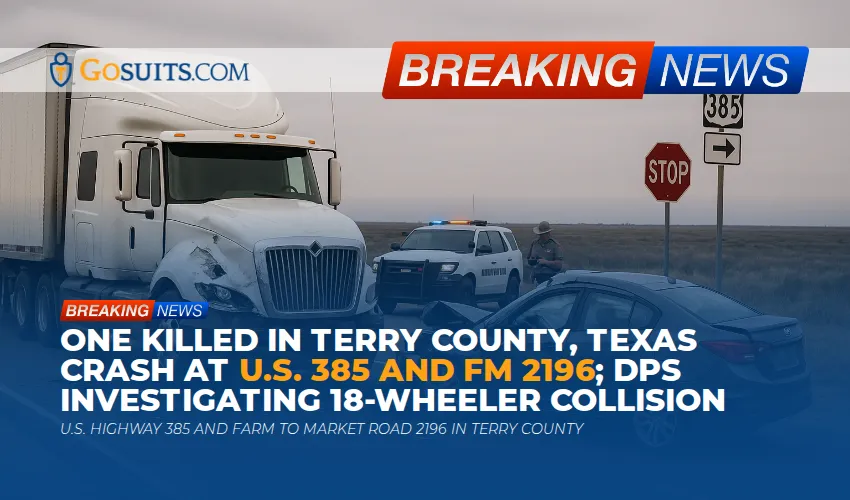- What happened on Westheimer early Friday
- Where the 9500 block sits and why it matters for safety
- What investigators have said so far
- How dangerous is Westheimer for people walking
- Rights and options for families after a fatal pedestrian crash in Texas
- What evidence matters on a corridor like Westheimer
- Agencies and offices to contact for records and support
- Insurance issues that often arise after pedestrian fatalities
- Common defenses and how fault is evaluated under Texas law
- Practical safety improvements on high-speed arterials
- What we still don’t know
- Time-sensitive steps that help in the days and weeks after a fatal crash
- Commentary from Gosuits Houston, Texas Personal Injury Attorney
What happened on Westheimer early Friday
A 73-year-old woman was struck and killed while walking along Westheimer Road early Friday morning near the 9500 block in west Houston. According to initial statements from the Houston Police Department (HPD), the westbound driver of a white Dodge Ram hit the pedestrian and stopped at the scene. Witnesses reported that a second vehicle also struck the woman but continued away. HPD noted that the Dodge Ram driver showed no signs of intoxication during the preliminary investigation. The woman’s name had not been released by authorities as of Friday afternoon pending family notification.
This tragedy occurred only two days after a national news analysis highlighted Westheimer as one of the most dangerous corridors for pedestrians in the United States. Residents in nearby neighborhoods like Tanglewilde, Briarmeadow, and the Westchase District know the stretch well. It is a corridor full of driveways, wide lanes, and heavy traffic that surges during rush hours and weekend nights, with people walking to bus stops, retail plazas, restaurants, and late-shift jobs.
Where the 9500 block sits and why it matters for safety
The 9500 block of Westheimer lies just east of Beltway 8, in the heart of the Westchase commercial area. It’s flanked by large shopping centers, multilane signalized intersections, and frequent driveway entrances. The combination of high traffic volumes, turning vehicles entering and exiting businesses, and long crossing distances creates a challenging environment for anyone on foot, especially at night or in low-light, rainy conditions. METRO bus stops along Westheimer bring people across the roadway between stops and destinations, and crossing midblock is common where crosswalks are far apart.
Even with improvements like new sidewalks in some segments, gaps can remain between curb ramps, refuge islands, and well-timed signals. On a corridor like Westheimer, small design details matter a lot: lighting that reaches the whole crosswalk, median islands that break up long crossings, and signal timing that gives slower walkers enough time to cross. When any of those are missing, the risk increases substantially.
What investigators have said so far
HPD’s preliminary account states the pedestrian allegedly failed to yield the right of way before entering the roadway. That is an initial assessment based on early information. In traffic death investigations, facts often develop over days and weeks. Detectives typically canvass for surveillance video, vehicle debris, skid marks, witness accounts, and electronic data from involved vehicles. If a second driver did strike the pedestrian and left the scene, locating that vehicle becomes a priority.
Families commonly want to know if roadway design, lighting, or signal timing contributed. Investigators may review those factors, but formal design evaluations can take longer and sometimes involve city engineers or the Texas Department of Transportation. It’s important to distinguish between what’s known on day one and what becomes clear after more evidence is gathered.
How dangerous is Westheimer for people walking
Westheimer is one of Houston’s busiest surface streets. While rankings can vary by methodology, the community experience is consistent: people walking along Westheimer face significant danger. National and federal data confirm pedestrian deaths have risen in recent years across the United States, especially on wide, high-speed arterial roads similar to Westheimer.
Key points supported by federal and local sources:
- Pedestrian fatalities have been rising nationally. National Highway Traffic Safety Administration (NHTSA) data show thousands of pedestrian deaths each year, with recent years showing an upward trend. See NHTSA’s pedestrian safety page and the Fatality Analysis Reporting System (FARS) for national data trends. Sources: NHTSA Pedestrian Safety; NHTSA FARS.
- Houston has adopted Vision Zero with a goal of eliminating traffic deaths and serious injuries. City materials recognize that large, fast roads pose specific risks for people outside vehicles and outline strategies for safer designs. Source: City of Houston Vision Zero.
What makes roads like Westheimer high risk? Multiple lanes, high posted speeds, long distances between safe crossings, frequent driveways, and heavy night-time activity. When those factors combine, the margin for error narrows. People walking may misjudge gaps. Drivers may not see a person in time, especially if lighting is poor or sight lines are blocked. Safety fixes are well known in the traffic engineering world and include midblock crossings where demand is high, median refuge islands, better illumination, protected turn phases, and leading pedestrian intervals.
Rights and options for families after a fatal pedestrian crash in Texas
When a loved one is killed in a crash, Texas civil law provides pathways for certain family members to pursue claims. These pathways exist to address medical bills, funeral costs, loss of companionship, and other harms recognized by law. The following is general information and not tailored to any one situation.
- Wrongful death claims. In Texas, certain family members may bring a wrongful death claim arising from a death caused by the neglect, carelessness, unskillfulness, or default of another. See Texas Civil Practice and Remedies Code Chapter 71. Source: Tex. Civ. Prac. & Rem. Code ch. 71.
- Survival claims. The decedent’s estate may pursue a survival action for damages the person could have claimed had they lived, such as conscious pain and suffering. Also within Chapter 71. Source: Tex. Civ. Prac. & Rem. Code ch. 71.
- Deadline to file. Many Texas wrongful death and survival cases carry a two-year statute of limitations, with some exceptions. Source: Tex. Civ. Prac. & Rem. Code §16.003.
- Shared fault and recovery. Texas uses proportionate responsibility. A claimant generally cannot recover damages if more than 50 percent responsible. Fault allocation is highly fact specific. Source: Tex. Civ. Prac. & Rem. Code ch. 33.
Families sometimes worry that an initial police statement about a pedestrian “failing to yield” ends their civil options. That is not how civil cases are resolved. Fault is evaluated under Texas statutes and case facts, and drivers have statutory duties toward pedestrians even outside crosswalks. See the Texas Transportation Code provisions below in the fault section.
What evidence matters on a corridor like Westheimer
On a retail-heavy corridor, time is the enemy of good evidence. Video systems overwrite quickly, debris is cleared, and witnesses disperse. The following items often become critical:
- Nearby surveillance video. Convenience stores, strip centers, banks, and apartment gates around the 9500 block often have exterior cameras. Many systems overwrite in days. Prompt outreach can make the difference between having clear footage and having none.
- Vehicle data. Modern vehicles store speed, brake, and steering inputs around the time of a crash. Securing that data requires timely steps.
- Scene documentation. Measurements of lane widths, lighting conditions, sight lines, crosswalk visibility, and signal timing can help reconstruct what happened, especially at night or before sunrise.
- Witness contact information. People who stopped briefly often have key details about vehicle paths or a second vehicle’s involvement.
- Road design and maintenance records. Signal timing sheets, lighting maintenance logs, and traffic studies can contextualize risk on a segment like Westheimer.
Because evidence disappears quickly in Houston’s busy corridors, prompt preservation efforts are essential. Statements given to insurance companies before facts are pinned down can be used later to challenge claims, so it’s wise to understand rights and obligations before making recorded statements.
Agencies and offices to contact for records and support
Several public agencies hold records or provide support in the aftermath of a fatal crash. These resources are specific to Houston and Texas:
- Houston Police Department. For updates or to provide information, HPD maintains public contact portals and can route to the appropriate investigative unit. Source: City of Houston Police Department contact.
- Official Texas crash report (CR-3). Certified crash reports are maintained by the Texas Department of Transportation and can be requested through TxDOT. Source: TxDOT Crash Reports.
- Harris County Institute of Forensic Sciences (Medical Examiner). For autopsy status, case numbers, and decedent release information. Source: Harris County IFS.
- Texas death certificates. Vital records, including death certificates, are available through the Texas Department of State Health Services. Source: Texas DSHS Vital Statistics.
- Victim services. The City of Houston offers victim services resources that may assist with navigating processes after a sudden loss. Source: City of Houston Victim Services.
- Vision Zero and safety requests. Concerns about lighting, crosswalks, or signals can be submitted through the city’s 311 service, which routes to Houston Public Works for review. Sources: Houston 311; Vision Zero Houston.
- National data context. For those seeking broader context about pedestrian danger trends or comparable corridors nationwide, see NHTSA’s FARS. Source: NHTSA FARS.
When requesting sensitive records, agencies may require proof of relationship, case numbers, or identification. Processing times vary, and some records are not released until investigations are further along.

Insurance issues that often arise after pedestrian fatalities
Insurance can be complex after a pedestrian death, especially where multiple vehicles or a hit-and-run may be involved. Several coverages could apply, depending on the facts:
- Liability coverage of at-fault drivers. If a driver negligently caused or contributed to the crash, their auto liability insurance may be a source of recovery. Determining fault requires evidence, not assumptions.
- Uninsured/Underinsured Motorist (UM/UIM). If a second vehicle fled or a responsible driver has insufficient coverage, the decedent’s own UM/UIM coverage can sometimes apply even when they were walking. Policies vary and must be read carefully.
- Personal Injury Protection (PIP) and MedPay. These coverages, when present on a Texas auto policy, may provide benefits without regard to fault. Eligibility and limits depend on the policy language.
- Commercial policies. If an involved vehicle was owned by a business or used for work, a commercial auto or umbrella policy may be implicated. Identifying the vehicle and its owner quickly becomes critical.
- Life and accidental death policies. Separate from liability issues, families sometimes pursue benefits under life insurance or accidental death and dismemberment policies.
Insurance adjusters often ask for recorded statements shortly after a crash. It is prudent to speak with a qualified attorney first. What someone says to an insurance company can be used to limit or deny claims later, especially before all evidence is collected and analyzed.
Common defenses and how fault is evaluated under Texas law
Texas law addresses both pedestrian conduct and driver duties. Even when a pedestrian crosses outside a crosswalk, drivers still owe duties of care. A few statutory provisions help frame the discussion:
- Pedestrians crossing outside crosswalks. When crossing outside a crosswalk, pedestrians generally must yield the right of way to vehicles. Source: Texas Transportation Code ch. 552.
- Driver duty to exercise due care. Drivers must exercise due care to avoid colliding with a pedestrian, sound the horn when necessary, and exercise proper precaution upon observing a child or an obviously confused or incapacitated person. Source: Transportation Code §552.008.
- Comparative fault. Under proportionate responsibility, a jury can assign percentages of fault among the parties. A claimant who is more than 50 percent at fault generally cannot recover, but if 50 percent or less, recovery may be reduced by the percentage of responsibility. Source: Tex. Civ. Prac. & Rem. Code ch. 33.
In practice, fault analysis considers sight distance, lighting, vehicle speed, braking, driver attention, pedestrian visibility, roadway design, and whether the driver could have avoided the collision by exercising due care. A preliminary statement that a pedestrian “failed to yield” does not end the inquiry. Evidence from cameras, vehicle data, and independent reconstructions is often central to a fair evaluation.
Practical safety improvements on high-speed arterials
Proven engineering countermeasures can reduce the frequency and severity of pedestrian crashes on roads like Westheimer. Federal Highway Administration (FHWA) guidance highlights several tools communities often deploy on high-crash corridors:
- Median refuge islands that allow people to cross one direction of traffic at a time.
- High-visibility crosswalks and enhanced lighting so drivers detect pedestrians earlier at night.
- Leading pedestrian intervals (LPIs) that give pedestrians a head start before turning vehicles move.
- Rectangular Rapid Flashing Beacons (RRFBs) or pedestrian hybrid beacons at busy midblock locations.
- Protected left-turn phases and turn-calming to reduce conflicts at intersections.
- Access management to reduce driveways and turning conflicts through shared entrances.
Sources and further reading: FHWA Pedestrian and Bicycle Safety; FHWA Proven Safety Countermeasures. These interventions are most effective when targeted to locations with demonstrated pedestrian activity and crash histories, such as the retail clusters and transit nodes common along Westheimer.
What we still don’t know
As of the last public update, several key facts remain open:
- Identification of the second vehicle allegedly involved and whether that driver will be located.
- Lighting and visibility conditions at the exact moment of impact, including whether nearby property lighting helped or hindered visibility.
- Exact crossing point relative to a marked crosswalk or signal and how signal timing factored in.
- Vehicle speed and evasive actions, which may depend on data downloads and reconstruction analysis.
These details matter for both safety reviews and any civil claims. It is common for the public narrative to shift as investigators assemble a fuller picture.
Time-sensitive steps that help in the days and weeks after a fatal crash
The period after a roadway death is overwhelming. Yet some steps, if taken promptly, can preserve crucial information and ease administrative burdens later. The following actions are general in nature:
- Preserve video quickly. Identify nearby businesses, apartments, and traffic-adjacent properties and request preservation of exterior camera footage for the hours surrounding the crash.
- Document the scene. Capture photos or video of lighting, crosswalk markings, sight lines, tire marks, vehicle debris, and nearby signage before the area changes.
- Track agencies and case numbers. Record HPD incident numbers, the Harris County IFS case number, and any TxDOT references to streamline later records requests.
- Order official records. Request the TxDOT CR-3 crash report when available and maintain copies of medical examiner documents and death certificates for estate and benefits processes.
- Coordinate with insurance cautiously. Before giving any recorded statements to an insurer, consult with an attorney to understand rights and potential implications. Statements can be used to dispute claims later.
- Secure vehicle inspections. If an involved vehicle is within the family’s control, keep it unaltered until it can be inspected and data preserved.
- List potential witnesses. Note names, businesses, and any individuals who stopped at the scene. Time makes details fade.
Why act now? Camera overwrite cycles are often measured in days, not weeks. Tire marks and debris are cleared quickly on Westheimer due to high traffic volumes. Signal timing or lighting changes can occur without notice. Early, methodical steps protect the factual record that later decisions rely on.
Commentary from Gosuits Houston, Texas Personal Injury Attorney
Our thoughts are with the woman’s loved ones and with everyone who travels Westheimer on foot or by car. This article is meant to share general information and context for the community. The loss of life on a neighborhood corridor hurts deeply because so many of us shop, dine, and commute along this very road.
Based on what’s been reported so far, the crash occurred on a difficult stretch of Westheimer near Beltway 8 that mixes fast traffic, wide crossings, and frequent driveways. Preliminary notes about a pedestrian “failing to yield” are one part of a larger picture. Texas law still requires drivers to exercise due care to avoid colliding with pedestrians. The presence of a possible second vehicle that left the area raises further questions about visibility, timing, and whether avoidable risks were present. On corridors like this, multiple small factors often combine into a deadly outcome.
In our experience, insurance companies and large corporations move quickly to shape the narrative. Adjusters may call within days seeking recorded statements, authorizations, or quick resolutions. Those early conversations can disadvantage families because key facts are still emerging and video or data may not yet be collected. Corporations with fleets and insurers with sophisticated claims teams understand these timelines and sometimes count on the confusion and grief of the immediate aftermath.
That is why a free consultation can make a practical difference. It helps people understand how Texas comparative fault works, which insurance coverages may apply, and what evidence should be preserved. It also gives space to make informed decisions before speaking with any insurer. No one can guarantee outcomes, but having clear guidance early can prevent costly mistakes and protect rights while the investigation continues.

Sources and references
- National Highway Traffic Safety Administration: Pedestrian Safety
- NHTSA Fatality Analysis Reporting System (FARS)
- City of Houston Vision Zero
- TxDOT Crash Reports
- Harris County Institute of Forensic Sciences
- Texas Department of State Health Services: Death Records
- Houston Police Department Contact
- Houston 311 Service
- Tex. Civ. Prac. & Rem. Code ch. 71 (Wrongful Death)
- Tex. Civ. Prac. & Rem. Code §16.003 (Limitations)
- Tex. Civ. Prac. & Rem. Code ch. 33 (Proportionate Responsibility)
- Texas Transportation Code ch. 552 (Pedestrians)
- FHWA Pedestrian and Bicycle Safety
- FHWA Proven Safety Countermeasures
Action steps to consider now
Retain and preserve evidence, request official records when available, and get legal guidance before engaging with insurers. Acting promptly helps protect the facts while memories and video are fresh. Delay can mean critical footage is overwritten and important data lost, which can affect accountability, claims, and community safety improvements moving forward.






